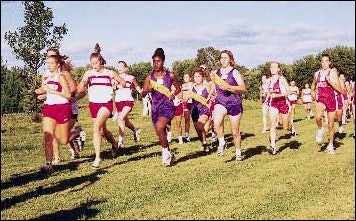A new Title IX companion law in Georgia targets rampant gender inequities.

When an Atlanta newspaper reported late last year that most of Georgia's 323 public high schools fielding athletic programs were in violation of Title IX, state Reps. Stephanie Stuckey (D-Decatur) and Kathy Ashe (R-Atlanta) decided to take action. They drafted a state companion to the federal law, guided it through the Georgia Legislature in three months and now show no signs of slowing down.
To garner support for the Equity in Sports Act, the two lawmakers used statistics compiled by The Atlanta Journal and Constitution. In an eight-day series that ran Dec. 12-19, reporters Mike Fish and David A. Milliron found that 75 percent of local school districts' salary supplements for coaching go to boys' sports, as does 95 percent of "extended pay" for coaching beyond the regular school year. The intent of the new law is to essentially wipe out those statistics and ensure Title IX compliance by requiring all schools to issue annual athletic-program reports to the Georgia Board of Education or face possible sanctions on post-season play and school funding.
"Times are changing," says Stuckey, who's considering compiling a how-to manual for officials in other states wanting to draft similar legislation. "Five years ago, this would not have passed in Georgia, because there's a different climate down here. But football is still king." In fact, when it comes to revenue generation, football remains king in most states, often helping keep a school's minor sports afloat. Perhaps that's why Stuckey says the greatest opposition to the bill came from football coaches and supporters who claim Title IX compliance will take even more money away from their sport to help fund other activities - including those for girls.
While it's unlikely Georgia football programs will die, the Equity in Sports Act could axe other sports in order for schools to comply, according to Tommy Guillebeau, executive director of the Georgia High School Association. "I think you might see some programs dropped," he says, adding that the law applies unnecessary pressure locally. "I see no reason for it, because we already have the law at the federal level."
But few schools abide by that law, according to the Journal and Constitution series. Fish and Milliron analyzed participation levels, funding, quality of facilities and coaching support for high school boys' and girls' sports at schools throughout the state, and they found a host of inequities. Among them:
- 64 percent of boys play competitive sports, compared to 36 percent of girls (38 percent, if cheerleaders are counted).
- 86 percent of the dollars derived from legislative grants aimed at supporting high school sports during a five-year period was directed toward projects in which the primary beneficiaries were boys.
- Less than half of Georgia's public schools offer girls' volleyball, which is the country's third most popular high school sport for girls.
- The ratio of students per coach statewide in football is 9 to 1; for softball and volleyball, it's 12 to 1.
The Equity in Sports Act will force school administrators to designate gender-equity coordinators and adopt plans to correct inequities. If problems persist for two years, a violating school could lose some state grants for athletic activities. A third year of violations could result in a ban from post-season play, and after four years, the state school board could withhold as much state money as it takes for the school to bring itself into compliance.
Furthermore, beginning in October 2003, the state board of education must give annual reports to the Legislature about the status of athletic participation in public schools based on gender and culled from information provided by individual schools. "I think it's airtight," Stuckey says about the bill. "It will be impossible to avoid this."
Similar laws exist in Florida and Minnesota. Florida's Educational Equity Act of 1994, for example, mandates that the proportion of girls in sports must mirror the school's student population within 5 percent. The Florida Department of Education also surveys schools each spring to determine compliance, and DOE officials visit schools slow to make improvements.
The law is working: Only 42 of 423 Florida public high schools were found in violation of federal Title IX law in 1998, according to the Journal and Constitution. Amid the seemingly endless deluge of Title IX-related actions and controversies, it's worthwhile to note that other states are providing more than traditional girls' sporting opportunities.
In Massachusetts, an Equal Rights Amendment in the state constitution has paved the way for girls to play such sports as boys' football and ice hockey. Hockey participation has been so great in recent years that many schools embarked on their own girls' programs. "The ice hockey story is a nice one," says Virginia Anderson, associate executive director of the Massachusetts Interscholastic Athletic Association. "We now have enough girls' ice hockey teams to sponsor an official tournament next year."
The state's ERA also means that Massachusetts schools not offering boys' swim, field hockey or gymnastics teams must allow boys to participate on girls' teams-even though doing so could decrease opportunities for other girls, as well as potentially change the fundamental nature of each sport, Anderson says. "Title IX is about expanding opportunities for young women, but hopefully not at the expense of young men," she explains. "But the trend nationally has been to increase opportunities for both girls and boys without having to field intergender teams. We're hoping that we can provide not just equal opportunities for boys and girls, but expanded opportunities."
Consider wrestling. While an increasing number of girls must wrestle on boys' teams in order to compete (68 in Massachusetts alone during the 1998-99 season), Brookline (Mass.) High School has its own girls' team. Five years ago, the school created what it claims is the first girls-only wrestling team on the East Coast, and it travels to New York City and other large metropolitan areas to find competition. The sport is gaining ground with female student-athletes nationally, too, as the third annual U.S. Girls' Wrestling Association Championships drew more than 400 participants to Lake Orion (Mich.) High School in March.
Such success stories are rarer in Georgia, where state high school officials have shown more interest in boosting such girls' fare as cheerleading than in developing more progressive activities such as girls' wrestling. Just two years ago, the association's executive committee voted resoundingly to keep competitive cheerleading as an official sport. That helps bolster female participation numbers and reduces the burden on schools to add such girls' scholarship sports as volleyball and softball. Only a handful of U.S. colleges and universities reportedly offer full scholarships for competitive cheer.
That's one reason why Stuckey, a former cheerleading captain herself, says there is plenty more to accomplish on the high school gender-equity front. Other issues relating to Title IX and boys' sports are worth addressing, too. "There are inequities not only between boys' and girls' sports, but also among boys' sports," she says.
The challenge continues.




































